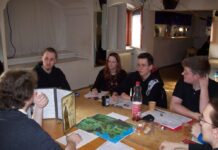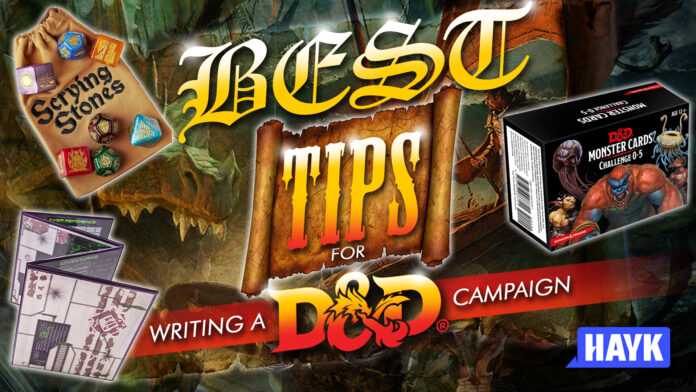
In Dungeons and Dragons or any other TTRPG, the Dungeon Master (DM) does everything. From writing the campaign to organizing the first session, the DM will always get his hands busy. Among all activities of the DM, the most important is the process of writing a campaign.
There’s no such thing as a universal approach for writing a D&D campaign. Every DM is unique with a personalized method or a ‘secret strategy.’ However, there are still some tried-and-tested methods that any DMs can use to build their campaigns.
This article will explore some useful tips for writing that can bring your new campaign from zero to one hundred as soon as possible.
Steps to Writing A D&D Campaign: The Important Tips
Determine Your Dungeons and Dragons Campaign’s Theme
So, how to write a campaign?
Campaign writing must start with a theme. The theme will serve as the springboard where other concepts or ideas can grow. To figure out a campaign’s theme, you must jot down your sources of inspiration or the D&D aspects that matter to you.
These are some popular DnD campaign themes:
- Epic fantasy
- Psychological horror
- Classic suburban horror
- Space opera
- Mecha
- Surreal fantasy
- Meat grinder (combat-focused)
- Holiday exclusive (i.e. Christmas-themed)
It’s possible to combine multiple themes in one campaign. However, you shouldn’t go beyond three themes because it might dilute your campaign’s core identity. Players experience burnout with confusing campaigns that try to achieve many things at the same time.
Create a Brief Outline
A simple outline will make almost everything easy – D&D included. With an outline, you’d see how the campaign will turn out. If a scene might feel difficult for players, you can adjust it by rebalancing encounters or offering extra safer options.
Your campaign outline can benefit from the traditional screenwriting format. Basically, a story must have a Beginning, Middle, and End. You’re still free to add arcs or extra chapters between sessions, but the right outline format will keep all story entries organized.
Check out this handy video guide on making a quick campaign outline:
Write Short Summaries of Key Locations
Locations are the strong driving factors of any D&D campaign. If an important plot element isn’t connected to a location, it can’t be discovered by players. This will cause the players to look all over the dungeon place as if they’re in a wild goose chase.
You don’t need long encyclopedic entries for campaign locations. Short summaries are enough, as long as they contain the information needed. You’ll have an easier time running a campaign if you can put summaries in handy index cards.
Copy Scenes and Revise Them
When it comes to writing a D&D campaign, copying a scene is normal. Perhaps you want to recreate the Battle of Gondor through several intricate scenes and plot threads. Just pluck out the scene, change some details, and include it in your campaign. There’s a moderate chance that players will bypass the scenes that you’ve made, so proper adjustment is needed.
Changing or revising scenes is an easy thing to do. You just have to review the players’ actions and figure out if a specific scene matches the flow of the story. Instead of throwing a scene (or encounter) away, you can reserve it for a side-quest of a minor adventure.
Since D&D is a game of change, keep your scene summaries concise. Tie these scenes to locations that players often visit. It’s even better if you can dole out rewards based on the scene’s complexity.
Prepare a List of Interesting NPCs
Even though locations are important in writing your D&D campaign, they are only secondary to NPCs or non-player characters. NPCs are extensions of the DM’s storytelling capabilities. These NPCs relay essential campaign information or other important leads that can push a story forward. NPCs can also point players to exciting locations like ruins or a dragon’s abandoned treasure hoard.
It’s easy to make an NPC or pluck a pre-generated choice online. But making an interesting and memorable NPC is challenging. Players won’t love all NPCs that you intend to create. Sometimes, they might even develop an act of hate towards a major NPC that’s supposed to give them the first quest. You must be ready with a backup NPC or a follow-up social encounter in such a situation.
A list of interesting NPCs is better than one or two options. To make the NPCs interesting, jot down their motivations, goals, and hidden agendas. Don’t overdo this process – each NPC should only have the right information that fits within an index card. This way, you can go over the index cards without stopping the session or flipping through a big notebook. You can also add visual cues to the index cards like colors, small drawings, and even stickers.
Write Down Multiple Starting Points
A campaign should only have one starting point, but players are unpredictable most of the time. They might do something that totally nullifies the starting point of your campaign. To prevent your campaign from getting derailed right at the beginning, you must be ready with multiple starting points.
If the players missed the game’s main quest in the tavern, then you can use an NPC from a nearby location to build up the plot. This NPC can reveal what the BBEG is up to. Or perhaps the NPC can share the lead to a powerful artifact.
Scenes can also open up new starting points. Throughout the first session, you can set up a scene that players can trigger. Such improvised, reactionary scenes can save a campaign from being derailed.
Create Meaningful Encounters and Conflicts
A D&D campaign is similar to a thick book or a long movie. Just like in a book, a D&D campaign must have the right number of meaningful encounters. And just like in a movie, the element of action shouldn’t be ignored.
Planning encounters in your head are easy, but setting up one is a different ordeal. The first thing you have to do is to figure out the purpose of the encounter. Some encounters are meant to establish social etiquette, while others are combat-based.
Here are some guide questions for setting up an encounter:
- Will this encounter push the story forward?
- Will this encounter give EXP, treasures, or both?
- What will my players learn from this encounter?
- What is the awesome thing about this encounter?
- Which NPCs are included?
- Which monsters are included?
- If this is a combat encounter, is there a remote chance of TPK?
- Can players discover a secret from the encounter?
Once you’ve determined a sense of the encounter’s purpose, take note of the ‘pieces’ involved. Make sure that all NPCs have cue cards or marker guides in a social encounter. Such small things will ease your mental burden while running a session. In a combat encounter, you just need to prepare stat blocks and review all the monsters’ behavior and tactical actions. Bear in mind that you don’t need to use everything in a stat block. It’s okay to change some minor details here and there.
Use Characters’ Backstories to Enrich Your Campaign
The backstory is not just a static part of the character sheet. Rather, it is a creative turnkey that can connect the characters to the plot. A backstory can also lead to new opportunities of improving your campaign. Maybe one of your character’s shadowy past can be a part of an NPC’S origin story. Or perhaps a character’s personal goal can become a major hurdle for your campaign’s antagonist.
Encourage your characters to flesh out their backstories but remind them not to overdo the process. You don’t need a novel for a backstory. Just a few paragraphs of a decent origin story will do.
Explore Different Types of Literature
Literature is the primary factor that will help you become a better D&D campaign builder. If you’re going to observe deeply, you’d realize that all aspects of D&D come from all types of literature. Take a look at the western and oriental creatures in the Monster Manual. The structure of common D&D adventures is also similar to the style of fantasy books or movies.
By exploring numerous mediums of literature, your ‘DM perspective’ will improve. Eventually, this improvement can lead to a better campaign structure, dynamic NPCs, and meaningful social and combat encounters.
During your campaign-writing break, try to watch a couple of popular fantasy movies. The Lord of the Rings trilogy is a remarkable choice, followed closely by Narnia. Aside from movies, you can read famous fantasy novels like Dragonlance, Greyhawk, and Forgotten Realm official titles. These fantasy books are closely linked to D&D, and they are the usual settings of many adventures worldwide.
Useful Books to Help You Build A D&D Campaign
The 5E Dungeon Master’s Guide
The Dungeon Master’s Guide (DMG) is a real treasure for DMs and players alike, brimming with useful details, beautiful artwork, and inspiring lore entries. Every section of the DMG is clearly written and organized, making the information accessible to beginner DMs. If you’re not in the mood to write a campaign, just reading the DMG will get your creative juices flowing.
You don’t need to use the DMG as an exact booklet of D&D rules. Just focus on essential things like combat rules and equipment information. More importantly, you should enjoy the best bits offered by the book!
Awesome Factor: All-around reliable guide for Dungeon Masters
The 5E Player’s Handbook
Another important book D&D book that you shouldn’t miss is the Player’s Handbook. This book contains all the mechanical aspects that players and DMs should know. Some of the book’s best parts are character creation, races and classes, combat rules, and detailed spell lists. If you want to run a campaign smoothly, you must read all of the Player’s Handbook’s chapters.
Lore is a small part of the Player’s Handbook since nearly everything is technical. Consider the Player’s Handbook as an all-in-one encyclopedia that will give you the resources needed to make powerful NPCs, thrilling encounters, and balanced rewards.
Awesome Factor: Great for learning D&D’s technical stuff
The Dungeon of the Mad Mage
Dungeon of the Mad Mage is the sequel adventure to Waterdeep Dragon Heist for many players. While the players aren’t wrong, Dungeon of the Mad Mage is also a useful, feature-rich sourcebook meant for DMs.
The Dungeon of the Mad Mage is all about the Undermountain – the living lair of Halaster Blackcloak. Each dungeon floor of the Undermountain contains unique characters, a separate storyline, creeping monsters, and lots of treasures. If you’re a DM with little time, you can just pluck any of the floors and replace the monsters with some baddies that you’ve prepared. You can even change the aesthetics of the dungeon and turn it into virtually anything.
Dungeon of the Mad Mage is a must-have for all DMs. Halaster Blackcloak is also an awesome BBEG or NPC that you can recycle as often as you’d like.
Awesome Factor: Unique dungeons that can be retextured into custom adventures
Tales From The Yawning Portal
Tales from the Yawning Portal is a great book to read and explore. It contains the most popular D&D adventures, such as Sunless Citadel, Tomb of Horrors, and Dead in Thay. The book is loaded with lore and dungeon designs that will help you write an engrossing campaign.
All of the adventures included in the Yawning Portal are stand-alone. You can run them directly or revise them into different dungeons. If your players are beginners, you probably need to adjust some encounters and decrease their lethality.
Awesome Factor: Great lore build-up and high-octane adventures
The Monster Manual
Every aspiring DM must have a copy of the Monster Manual. This book is all about monsters and their respective behavior and stat blocks. You can find nearly all types of monsters in MM, ranging from simple apes to hair-raising evil liches.
It’s perfectly fine to ignore the monsters in MM and use your own versions. But by using MM’s monsters, you can save time and precious mental energy while building encounters. MM’S detailed monster information is also fun to read, and the artwork is superb.
Awesome Factor: Detailed list of official D&D monsters
Volo’s Guide to Monsters
A supplementary piece for the Monster Manual, Volo’s Guide to Monsters contains fleshed-out information about monsters and their lairs. The best thing about this book is the seamless combination of mechanics and lore. It’s as if you can’t separate the monsters’ technical information from their lore and vice versa. VGTM also offers the chance for players to make monster characters based on various monsters like hobgoblins, bugbears, and gnolls.
Awesome Factor: Improved monster lairs, behaviour, and monster racial options
Mordenkainen’s Tome of Foes
Mordenkainen’s Tome of Foes is a profound book that discusses concepts beyond the Material Plane. This book can read about the eternal conflict between Demons and Devils known as the Blood War. The book also highlights the key differences between a manipulating Devil and a chaotic, battle-frenzied Demon. Other interesting parts are lore entries about the Gith (Githyanki and Githzerai), Drow, and Duergar.
To boost the overall challenge of your campaign, you should consider the monster stat blocks presented in Tome of Foes. There are lots of demons and devils to choose from, and they can all be retextured to whatever forms you desire.
Awesome Factor: Remarkable otherworldly lore and powerful stat blocks
Xanathar’s Guide to Everything
Reading Xanathar’s Guide to Everything is like browsing a mega-magazine filled with exciting things and details. This book contains a plethora of new subclasses, racial options, spells, and powerful magic items. Nearly every part of XGE can inspire you to make the building blocks of your campaign. The subclasses are nice examples because they can expand your campaign world in many creative ways.
Xanathar’s Guide to Everything is a great gift for D&D aficionados and dedicated nerds. Not only will players gain extra customization options, but they can even have something awesome to read about.
Awesome Factor: Great customizable options and magic items for players
Guildmaster’s Guide to Ravnica
Ravnica is a popular setting in the Magic the Gathering universe. When Wizards of the Coast managed to acquire the full license of D&D, the plane of Ravnica entered the tabletop industry. The Guildmaster’s Guide to Ravnica is a fantastic reading material that contains rich information about Ravnica’s prominent guilds. Since Ravnica is an ecumenopolis (a world-sized city), it is governed by powerful guilds with multiple agendas and capabilities.
If you love to inject faction politics into your campaign, you won’t be disappointed with GGTR. The book will show you how to design a faction from scratch – complete with lore and necessary information.
Awesome Factor: Great for understanding faction dynamics and faction politics
Best Accessories for Any Aspiring DMs
Hexers Game Master Screen
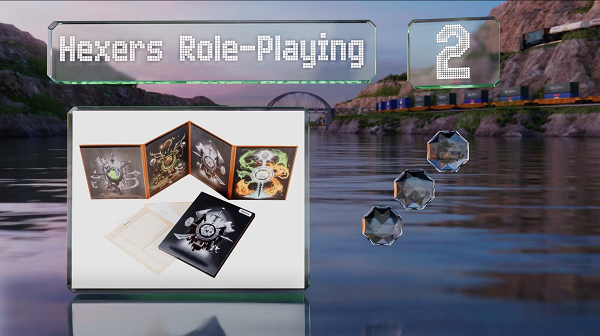
The Hexers GM screen is more than just the average DM screen accessory. It is made of strong cardboard material segmented into four panels with sheet pockets. The panels are flappable, allowing you to change themes whenever needed.
Aside from the screen, the Hexer GM box has a bundle of D&D 5E cheat sheets that you can insert into the pockets. After inserting the cheat sheets, you can now check the information needed without flipping a thick book. The cheat sheets are essential in combat encounters where progress seems to slow down due to constant backtracking.
There’s also a free dry-erase sheet that you can use for tracking player location or drawing stuff. This sheet is also useful for putting exclusive DM reminders and relevant information.
D&D Monster Cards
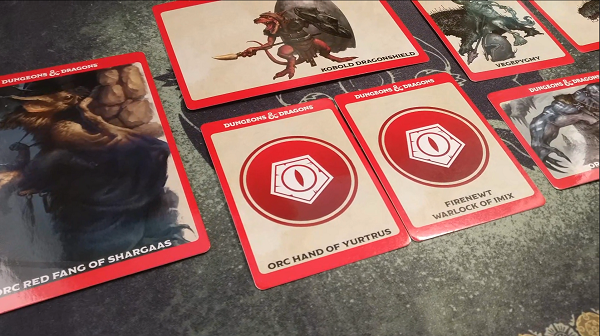
Are you looking for an easier way to check monsters without navigating the detailed pages of the 5E Monster Manual? In this case, you should get a box of official D&D monster cards. These laminated cards contain the popular (or most used) monsters of D&D. The included monsters are also compatible with Volo’s Guide to Monsters.
Monster cards are great for providing visual cues for monsters and enemies. This will eliminate confusion at your table and speed up your players’ tactical decisions.
Scrying Stones Scenario Dice Set
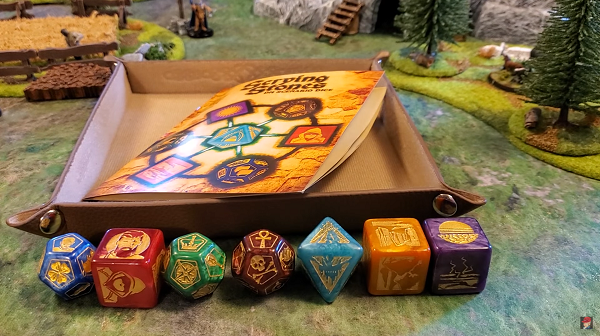
Any personal trinket that can randomize stuff is a real boon for any DM. This is the reason why gaming dice sets are so popular, aside from their clicking sounds and fancy colors. Random effects excite the primal brain despite the presence of imminent danger or failure. Sometimes, the regular dice set is not enough to create better random effects.
The best alternative is a scrying stone D&D dice set. In this set, you’d find seven colorful stones with random symbols. These symbols pertain to characters, weather, loot, locations, quirks, and jobs. If an encounter needs an immediate NPC and you haven’t prepared one, just roll the scrying stones. You can have a fleshed-out NPC ready to direct the party to their next quest in less than a minute.
The scrying stones dice set comes with a reference guide to help you understand the symbols. There are also guide questions for new characters and some handy character tables.
Writing a D&D Campaign – FAQ
Can I write a campaign without an outline?
Answer: Yes, but writing a campaign blindly can lead to unbalanced encounters and constant adjustment. Players will barely notice any changes as long as you’re comfortable with improvisation. Outlines are advisable for beginners and experienced DMs alike.
How many ‘filler’ arcs should my campaign have?
Answer: Filler arcs give way to mini-quests and opportunities for exploration. You should prepare at least three filler arcs even though players might not explore them all.
What is the difference between an adventure and a campaign?
Answer: The difference is minimal. An adventure represents a shorter game usually finished in less than three sessions. A campaign requires a longer time commitment and can bring characters from Level 1 to Level 20. Typical campaigns last for more than a year or two.
Should I optimize my campaign’s monsters to give players the best fights?
Answer: Optimizing monsters is part of a DM’s checklist of responsibilities. You should optimize monsters in a way that will challenge players. Adding extra tactical options for enemies will make any encounter worthwhile.
Do I need to follow the Dungeon Master’s Guide for building my campaign?
Answer: You don’t have to, but the DMG will make everything easier. The Dungeon Master’s Guide contains a hefty amount of information such as travel rules, campaign creation tips, equipment lists, planar guides, and detailed magic items.
End Remarks
Writing a D&D campaign can be difficult at first, but you’ll have an easier time by following the tips in this article. Just remember that patience is important because no one can make a perfect campaign in the first few tries. Trust the process, and you’ll definitely improve as a professional DM, worldbuilder, or campaign writer.
Do you have a thriving fantasy world ready to be shared with new players? Tell us about your world and campaign in the comments section below!


